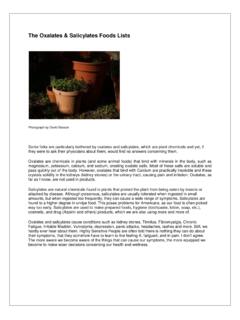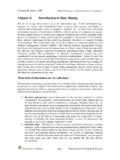Transcription of Polysorbates 20 and 80 used in the formulation of protein ...
1 Polysorbates 20 and 80 Used in the formulation of protein Biotherapeutics: structure and degradation Pathways BRUCE A. KERWIN. Department of Pharmaceutics, Amgen Inc., One Amgen Center Dr., Thousand Oaks, California 91320. Received 14 June 2007; revised 9 August 2007; accepted 8 September 2007. Published online in Wiley InterScience ( ). DOI ABSTRACT: Polysorbates 20 and 80 (Tween1 20 and Tween1 80) are used in the formulation of biotherapeutic products for both preventing surface adsorption and as stabilizers against protein aggregation. The Polysorbates are amphipathic, nonionic surfactants composed of fatty acid esters of polyoxyethylene sorbitan being polyoxyethy- lene sorbitan monolaurate for polysorbate 20 and polyoxyethylene sorbitan monooleate for polysorbate 80. The Polysorbates used in the formulation of biopharmaceuticals are mixtures of different fatty acid esters with the monolaurate fraction of polysorbate 20 making up only 40 60% of the mixture and the monooleate fraction of polysorbate 80 making up >58% of the mixture.
2 The Polysorbates undergo autooxidation, cleavage at the ethylene oxide subunits and hydrolysis of the fatty acid ester bond. Autooxidation results in hydroperoxide formation, side-chain cleavage and eventually formation of short chain acids such as formic acid all of which could influence the stability of a biopharmaceutical product. Oxidation of the fatty acid moiety while well described in the literature has not been specifically investigated for polysorbate. This review focuses on the chemical structure of the Polysorbates , factors influencing micelle formation and factors and excipients influencing stability and degradation of the polyoxyethylene and fatty acid ester linkages. 2007 Wiley-Liss, Inc. and the American Pharmacists Association J. Pharm Sci 97:2924 2935, 2008. Keywords: polysorbate; Tween; surfactants; stability; degradation ; micelle; proteins;. protein formulation ; excipients; degradation INTRODUCTION maintained in a specific, three-dimensional con- formation.
3 This conformation is only marginally The proper formulation of recombinant proteins for stable, and thus relatively minor perturbing pharmaceutical products is vital to their long-term forces can disrupt protein structure causing loss stability and reproducible activity. To maintain of biological activity or an immunological response. biological activity, proteins generally must be Such perturbations are commonly encountered as proteins are produced, stored, transported, and delivered to patients. For example, it is well Abbreviations: HSA, human serum albumin; CMC, critical known that during common industrial processes micelle concentration; PEG, polyoxyethylene glycol. such as filtering,1 storage,2 agitation3,4 freeze/. Correspondence to: Bruce A. Kerwin (Telephone: 805-447- 0712; Fax: 805-447-3401; E-mail: thawing,5 7 lyophilization,8 10 nebulization,11 and Journal of Pharmaceutical Sciences, Vol.)
4 97, 2924 2935 (2008) spray drying1,12 17 proteins can suffer damage to 2007 Wiley-Liss, Inc. and the American Pharmacists Association their native conformation. Further, delivery of 2924 JOURNAL OF PHARMACEUTICAL SCIENCES, VOL. 97, NO. 8, AUGUST 2008. Polysorbates USED IN protein BIOTHERAPEUTICS 2925. protein pharmaceuticals to patients may also and mechanisms through which they may interact provoke losses of conformational integrity via with proteins. This article reviews the structure unfavorable interactions of proteins with surfaces and stability of Polysorbates 20 and 80, the most ( , inner walls of catheter tubing or syringes).18 commonly used nonionic surfactants in the biotech- Surface-active agents, or surfactants, are often nology industry. For information on the interaction added to protein solutions to prevent physical of polysorbate 20 and 80 with proteins the reader is damage during purification, filtration, transporta- referred to the review by Randolph and tion, freeze-drying, spray drying, storage, and delivery.
5 Human serum albumin (HSA) was initi- ally used in a number of protein formulations as a POLYSORBATE structure . stabilizer to prevent surface adsorption. Recent concerns though about the presence of infectious The Polysorbates are amphipathic, nonionic sur- agents ( , viruses, prions) in blood products has factants composed of fatty acid esters of polyoxye- prompted many regulatory agencies to no longer thylene Polysorbate 20 (polyoxyethylene allow its use forcing the exploration of other options. sorbitan monolaurate) and Polysorbate 80 (poly- Towards that end Polysorbates , nonionic surfac- oxyethylene sorbitan monooleate) are the most tants, are increasingly being used as replacements common Polysorbates currently used in formulation for HSA. The Polysorbates are both biocompatible of protein Their structures and excellent stabilizers against surface adsorption. are shown in Figure 1.
6 The structures shown here However, they must be used with caution since are those of the chemically homogenous poly- under some conditions there degradation can lead sorbates. Solutions of polysorbate sold by manu- to chemical modification of proteins and interac- facturers and labeled as polysorbate 20 or 80 are tions with some proteins may lead to changes chemically diverse mixtures of different fatty acid in conformational structure with unknown con- esters23 25 and will be discussed later. Both types of ,19 To prevent problems from occurring Polysorbates have a common backbone and only it is important to understand the issues associated differ between the structures of the fatty acid with there use including their structure , stability, side chains. The hydrocarbon chains provide the Figure 1. Chemical structure of Polysorbates 20 and 80. w x y z refers to the total number of oxyethylene subunits on each surfactant molecule and may not exceed 20.
7 DOI JOURNAL OF PHARMACEUTICAL SCIENCES, VOL. 97, NO. 8, AUGUST 2008. 2926 KERWIN. hydrophobic nature of the Polysorbates while the fatty acid species while the oleic acid containing hydrophilic nature is provided by the ethylene oxide component of polysorbate 80 is 58% of its subunits. The common backbone structure is a total. The remaining fatty acids are a mixture of sorbitan ring with ethylene oxide polymers attached both saturated and unsaturated fatty acids with at three different hydroxyl positions. While the caproic, caprylic, capric, and lauric acids being number of repeat ethylene oxide subunits varies at present only in polysorbate 20 with all other each position their total number (w x y z) fatty acid esters present in both polysorbate equals 20 and is constant for each polysorbate. 20 and 80 solutions. Analysis of Polysorbates The fatty acid moieties are attached through an from different vendors using reverse phase HPLC.
8 Ester linkage to the ethylene oxide oxygen at the z coupled with a charged aerosol detector has position. The laurate moiety of polysorbate 20 is a shown only minor differences in the fatty acid straight chain hydrocarbon structure and the oleate contents between mixtures from different suppli- moiety of polysorbate 80 contains a double-bond ers (Sungae Park, personal communication). A. forming a kink in the hydrocarbon chain. supply of polysorbate 80 made of 99% pure oleic The Polysorbates used in the manufacture of acid is now available from NOF Corporation albeit drugs, both biotechnology and pharmaceutical, this has not made its way into manufactured are sold either as polysorbate 20 or 80 or under products. The majority of Polysorbates are produc- the trade names Tween1 20 and Tween1 80. In ed using strictly plant sources and are the requir- the literature the names polysorbate and Tween ed Polysorbates used in biotechnology products.
9 Are used interchangeably and both should be The information regarding the source of the fatty searched for retrieving articles from Medline1 or acids used to manufacture the Polysorbates can be other indexing services. As stated earlier poly- obtained from the manufacturer. sorbate solutions are generally sold as mixtures of the fatty acid 25 The European Pharma- copoeia26 defines the percentage of the different SOLUTION AND SURFACE ACTIVE. fatty acid esters of each polyoxyethylene sorbitan PROPERTIES OF POLYSORBATE. that must be present in each solution. The United States Pharmacopoeia does not define the compo- Because of their dual hydrophobic/hydrophilic sition of the fatty acid esters present in the nature, surfactants in solution tend to orient solutions. The compositions of the mixtures and themselves so that the exposure of the hydrophobic chemical structures are shown in Table 1.
10 As can portion of the surfactant to the aqueous solution be seen the lauric acid containing component of is In systems containing air/water polysorbate 20 is 40 60% of the total number of interfaces, surfactants will tend to accumulate at Table 1. Fatty Acid Contents of Polysorbate 20 and 80. EU Specifications Acid PS-20 (%)a PS-80 (%)b structure Caproic 1 CH3(CH2)4 COOH. Caprylic 10 CH3(CH2)6 COOH. Capric 10 CH3(CH2)8 COOH. Lauric 40 60 CH3(CH2)10 COOH. Myristic 14 25 5 CH3(CH2)12 COOH. Palmitic 7 15 16 CH3(CH2)14 COOH. Palmitoleic 8 CH3(CH2)5CH . CH(CH2)7 COOH. Stearic 7 6 CH3(CH2)16 COOH. Oleic 11 58 CH3(CH2)7CH . CH(CH2)7 COOH. Linoleic 3 18 CH3(CH2)5CH . CH(CH2)7 COOH. Linolenic 4 CH3(CH2)4CH . CHCH2CH CH(CH2)7 COOH. a European Directorate for the Quality of Medicines and Healthcare. European Pharmacopoeia On-line. 5th Edition 2007, 01/. 2005:0426. b European Directorate for the Quality of Medicines and Healthcare.









